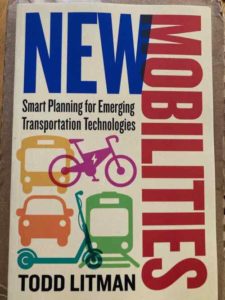New (ish) Book — ‘New Mobilities: Smart Planning for Transportation Technologies’ by Todd Litman
 Mobility is very important to our lives, and humankind continues to consider new/different modes of transportation. Both of my grandfathers were born in simpler times: 1886 & 1899. The latter was my maternal grandfather, he lived until the age of 97. He saw and experienced many forms of mobility in his lifetime. Though he died just 20 miles from his birthplace he flew to both coasts and drive/rode to many places in his long life….including visiting me in St. Louis in his last few years.
Mobility is very important to our lives, and humankind continues to consider new/different modes of transportation. Both of my grandfathers were born in simpler times: 1886 & 1899. The latter was my maternal grandfather, he lived until the age of 97. He saw and experienced many forms of mobility in his lifetime. Though he died just 20 miles from his birthplace he flew to both coasts and drive/rode to many places in his long life….including visiting me in St. Louis in his last few years.
How we all get from A to B is so important from a technology, environmental, policy, etc perspective. A recent book from a transportation expert Todd Litman explores the subject:
New transportation technologies can expand our world. During the last century, motorized modes increased our mobility by an order of magnitude, providing large benefits, but also imposing huge costs on individuals and communities. Faster and more expensive modes were favored over those that are more affordable, efficient, and healthy. As new transportation innovations become available, from e-scooters to autonomous cars, how do we make decisions that benefit our communities?
In New Mobilities: Smart Planning for Emerging Transportation Technologies, transportation expert Todd Litman examines 12 emerging transportation modes and services that are likely to significantly affect our lives: bike- and carsharing, micro-mobilities, ridehailing and micro-transit, public transit innovations, telework, autonomous and electric vehicles, air taxis, mobility prioritization, and logistics management. These innovations allow people to scoot, ride, and fly like never before, but can also impose significant costs on users and communities. Planners need detailed information on their potential benefits and impacts to make informed choices.
Litman critically evaluates these new technologies and services and provides practical guidance for optimizing them. He systematically examines how each New Mobility is likely to affect travel activity (how and how much people travel); consumer costs and affordability; roadway infrastructure design and costs; parking demand; land use development patterns; public safety and health; energy and pollution emissions; and economic opportunity and fairness.
Public policies around New Mobilities can either help create heaven, a well-planned transportation system that uses new technologies intelligently, or hell, a poorly planned transportation system that is overwhelmed by conflicting and costly, unhealthy, and inequitable modes. His expert analysis will help planners, local policymakers, and concerned citizens to make informed choices about the New Mobility revolution. (Island Press)
Here are the chapters so you can see how it’s organized.
Chapter 1: Introduction
Chapter 2: The Arc of Transportation History
Chapter 3: The Context of Transportation Planning
Chapter 4: A Comprehensive Evaluation Framework
Chapter 5: Evaluating the New Mobilities
Chapter 6: Analysis: How New Mobilities Can Achieve Community Goals
Chapter 7: Recommendations for Optimizing New Mobilities
Chapter 8: Conclusion
I couldn’t find a preview, but the author participated in a webinar discussing the topics in this book. This is a long presentation, but I found it interesting,
Like most new books I receive, this book isn’t a splashy coffee table book. It’s a “deep dive” into the subject. If you’re also a policy wonk then you’ll love Todd Litman and his latest book.
— Steve Patterson
b